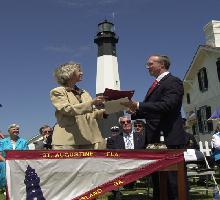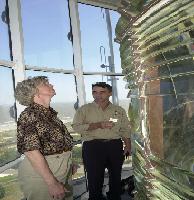

| Office of the Secretary | |
| For Immediate Release: June 10, 2002 |
Secretary Norton Announces First Lighthouses
Selected under National Preservation Program
- Tybee Island and St. Augustine Light kick off historic preservation project -
Savannah, Ga.-- Interior Secretary Gale Norton today launched the National Historic Lighthouse Preservation Program from the base of the Tybee Island Lighthouse near Savannah, Ga. Secretary Norton announced the first four lighthouses, including Tybee, to be transferred from the Coast Guard for their long-term care and visitor enjoyment.
 Secretary Gale Norton presents a letter for recommendation for transfer of the Tybee Island and St. Augustine lighthouses to Ed Fielder. |
"There is a mystique to lighthouses, a drama, a history, almost an aura of reverence for their lifesaving function. People are drawn to them. It is not surprising that historians, lighthouse buffs, and just plain citizens have been part of an effort to rescue lighthouses from either disrepair or neglect," Secretary Norton said. "At Tybee Island, we have seen the type of care that our lighthouses need. The Tybee Island Historical Society ensures that this national treasure will remain one of America's most historic light stations."
The National Historic Lighthouse Preservation Act of 2000 authorizes the transfer of historic lighthouses and stations at no cost to federal agencies, state and local governments, nonprofit corporations and community development organizations.
"The law places preservation of the historic light station first. It directs federal agencies to work with the General Services Administration and the National Park Service to choose the best stewards for long-term preservation," Secretary Norton said.
 Secretary Gale Norton takes a tour of the Tybee Island lighthouse will Cullen Chambers, Executive Director of the Tybee Island Historical Society. |
"One of the outstanding features of this law is that it puts nonprofits on an equal footing with government in becoming partners in the preservation of lighthouses. It takes communication, cooperation and consultation to find local organizations who want to work with a lighthouse because it is close to their towns, close to their homes and close to their hearts," Secretary Norton concluded.
The Department of the Interior decides the best possible steward(s) for each lighthouse. Norton recommended that the Tybee property be transferred to the Tybee Island Historical Society. Tybee Island is among the first four approved lighthouses of the 301 recommended for transfer. Tomorrow the secretary will travel to Michigan to announce further lighthouse transfers.
In addition, the St. Augustine Light on Anastasia Island near St. Augustine, Fla., is being transferred to the St. Augustine Lighthouse & Museum. On Sunday, the Rondout Creek Light at Kingston Point on the Hudson River in New York was transferred to the City of Kingston; and the Esopus Meadows Lighthouse on the west side of the Hudson River, near Esopus, N.Y., was transferred to the Esopus Meadows Lighthouse group.
Tybee Island: Located at the entrance to the Savannah River, the Tybee Island Light Station was built in 1773, although an earlier lighthouse on Tybee Island dates back to 1736. It is one of the oldest lighthouses in existence. In 1862, a Confederate force set fire to the wood, destroying the stairs and landings of Tybee Lighthouse to put it out of commission in advance of Union forces taking over the island. But the Union forces repaired the damage and used it as a lookout to watch Confederate forces at nearby Fort Pulaski.
The U.S. Lighthouse Commission considered decommissioning Tybee Island station in 1933. But they found it so efficiently run by the lightkeeper, George Jackson, that they found it more cost-effective to leave him in place. To this day, members of his family are employed or serve as Tybee volunteers.
St. Augustine Light: In 1824, a 16th century Coquina Spanish watchtower was modified in St. Augustine to become Florida's first lighthouse. Unfortunately the encroaching ocean threatened the foundation, and a new one was built. Keepers moved into the new lighthouse in 1876; and just four years later, the old one crashed into the sea.
St. Augustine also played a part in the Civil War when Confederate sympathizers removed the Fresnel lens and hid it. The Union eventually recovered the lens, and it is one of only 13 of its size still in use today. In World War II, the light was dimmed to prevent illumination of our ships for U-boats.
In 1955, the lighthouse was automated. Lamplighters were then employed to take care of the lens. In 1989, the last lamplighter retired, and the U. S. Coast Guard Auxiliary took over the maintenance of the light, which, like Tybee Island, remains an active aid to navigation. In 1971, St. Johns County purchased the Victorian keeper's quarters and surrounding property after a devastating fire in the abandoned home.
The board of county commissioners considered tearing down the gutted keepers' house but then leased it to the Junior Service League of St. Augustine Inc. for 99 years as a community service project.
A maritime museum was opened in the restored house eight years later. Rehabilitation of the adjacent lighthouse tower followed under a separate lease with the U.S. Coast Guard. By 1994 the tower opened full time to the public.
The St. Augustine Lighthouse & Museum was incorporated as a separate entity from the Junior Service League in January 1998.
It is a working lighthouse and museum that preserves and interprets the history of the St. Augustine Light Station and its associated maritime, coastal and social history.
- DOI -